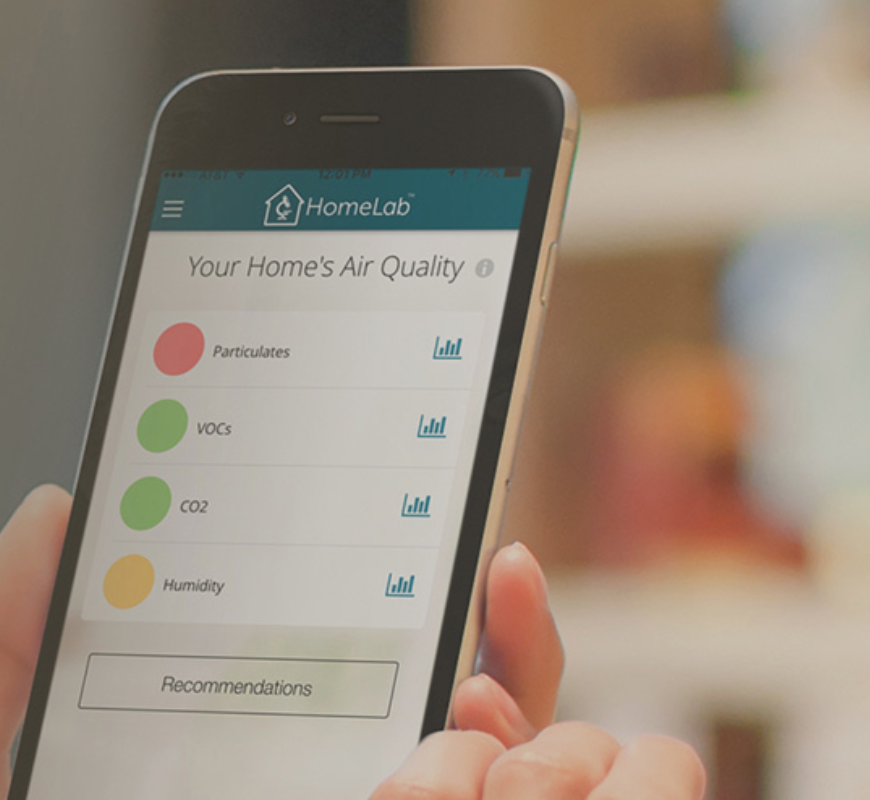 Did you know that the indoor air quality inside your home is actually more polluted than the air outside?
Did you know that the indoor air quality inside your home is actually more polluted than the air outside?
Photo credit: Philippe Put via Flickr / CC BY
Our homes are sanctuaries from the busy life outside. It’s where families reconnect daily to dine, rest and play.
Most people assume they live in a healthy home environment; however, this is most likely not the case. Our homes can trap pollutants, as well as generate them creating unhealthy indoor air quality.
Have you ever wondered what your home’s indoor air quality is? Do you wonder how you can remove pollution from your home without spending money?
HomeLab is a new, affordable service that can help. I am really excited about the services they provide!
HomeLab explains:
The EPA estimates that homes are 2-5 times more polluted than outdoors, and the World Health Organization ranks air pollution as the top global environmental risk1. When we think of “air pollution” however, we typically think of outdoor emissions from power plants and cars. Yet these emissions get trapped inside our homes, and products we use everyday generate pollution indoors.
1 http://www.who.int/mediacentre/news/releases/2014/air-pollution/en/((https://homelab.com/home-pollution/))
The Health Effects of Poor Indoor Air Quality
The United States Environmental Protection Agency (EPA) identifies the following short term and long term effects of poor indoor air quality.
- irritation of the eyes, nose, and throat
- headaches
- dizziness
- fatigue
- some respiratory diseases
- heart disease
- cancer((https://www.epa.gov/indoor-air-quality-iaq/introduction-indoor-air-quality))
Sources of Pollution in Our Homes
You may assume that all sources of indoor air pollution come from outside your home, but there are many sources within. From toxic cleaning products to furniture, your home is filled with potential sources. The EPA lists the following sources:
- Fuel-buring [sic] combustion appliances
- Tobacco products
- Building materials and furnishings as diverse as:
- Deteriorated asbestos-containing insulation
- Newly installed flooring, upholstery or carpet
- Cabinetry or furniture made of certain pressed wood products
- Products for household cleaning and maintenance, personal care, or hobbies
- Central heating and cooling systems and humidification devices
- Excess moisture
- Outdoor sources such as:
- Radon
- Pesticides
- Outdoor air pollution.((https://www.epa.gov/indoor-air-quality-iaq/introduction-indoor-air-quality))
Did you know that even your toaster can be a source of pollution in your home?
VOCs and formaldehyde can be generated from your hardwood floor (remember the Lumber Liquidators’ scandal) and carpeting, even your bedding!
Older homes breathe, yet the cleaner outdoor air remains trapped in crawl spaces and attics. These are typically dusty, dirty places in our homes. Modern homes that are sealed can trap indoor pollutants. No matter the age of your home, it can use some improvements for indoor air quality.
Indoor Air Quality Testing and Monitoring from HomeLab
If you are like my family, you may have bought expensive HEPA filters and a carbon monoxide alarm, but do you really know what your home’s indoor air quality is? I don’t, and I know it changes.
We are very excited about a new company called HomeLab. HomeLab provides a constant monitoring of your home’s indoor air quality
This affordable service provides you with an air quality monitor. Using an app on your smartphone, you can view the current levels of pollutants in your home. HomeLab then offers advice to clean the air by leveraging what your home already has, like bathroom fans.
See pollutant trouble brewing. Connect the monitor to your wi-fi and you’re on your way to a cleaner home.
View pollution levels, and get step-by-step recommendations on how to clean your air.Building Scientists
Our certified experts are dedicated to cleaning your air, guiding you through each recommendation and providing additional tips.((https://homelab.com/#product))
We tried out HomeLab’s services. What I really love is the company’s emphasis that you don’t have to spend money to improve your home’s indoor air quality.
Here’s how HomeLab works:
After signing up, you begin by opening reports on the app to view your current indoor air quality conditions.

Next, you click on recommendations to view low-cost solutions for your home’s specific air quality. The best thing about these recommendations is they are free!
After you try the simple recommendations, then check your report to see if they are effective. The emphasis is on the first step, using your home’s existing infrastructure to improve indoor air quality. It is only after you try these simple solutions, that you may want to purchase additional products and services HomeLab experts recommend.
When I spoke with one of the building scientists, I learned that something as simple as running your bathroom fan for more than just showers could remove VOCs and particulates from your home, as well as humidity.
Other suggestions include using stove vents/fans while cooking. They can be noisy, but newer ones are more efficient and quieter. HomeLab can help you choose an effective, quiet one when you are ready for an upgrade.
HomeLab also suggests you upgrade HVAC filters to higher efficiency high carbon ones, as well as set reminders to change them.
Other suggestions to improve indoor air quality include:
- Keep interior doors open, as rooms can be pockets of pollution
- Use natural cleaning products
- Switch to low VOC or no VOC paints
- Only use cotton wick candles that are unscented or use essential oils
Depending on your specific report, you will get recommendations. These recommendations start with easy steps you can take now to improve your home’s indoor air quality now. If those steps don’t work, proven home improvements, such as sealing air ducts rather than cleaning them, are advised.
My father and stepmother have taken many steps to clean the air in their home due to allergies. When discussing the steps they have taken with a building scientist at HomeLab, I discovered they could have taken simple actions to remove pollutants before making major home improvements. Without monitoring, such as the service provided by HomeLab, I wonder if they even know if their home improvements work or were even neccessary.

I recommend you sign up for HomeLab’s 30-day free trial. There’s nothing to pay or lose! Sign up now!
Using the equipment you already have like fans and HVAC and setting reminders with the HomeLab app, you can remove a significant amount of pollutants from your home. Take for example the Kodical family. They have been using HomeLab for one year and have cut their particulates and VOCs in half!
As you remove pollution from your home, pollution is still be generating, thus there is a need for monitoring. HomeLab is a great service to make sure your home is not making you sick. They are here to help you improve your indoor air quality consistently over time.
Hi Jennifer! This is so interesting! Definitely worth trying it out before investing in expensive devices or renovations. I looked around at the HomeLab website and couldn’t figure out if you have to pay for the Foobot monitor. I can’t imagine that they’d be giving it away for free. Can you tell me how that works?
Good question! I will ask
“The answer to the question is that the Foobot monitor is included in the monthly fee. You do not have to pay for it separately. You just need to return it whenever you no longer want the service. We tried to make it as easy as possible for people to get started cleaning their air!”
HomeLab makes it so easy!!!!
Cool! Thanks!
This is a super cool service! I can’t believe I’ve never heard of it. Now that you’ve been using it for a while, have you noticed improved health and well-being?
I only used it during a trial period for the purpose of the review.
I don’t think that many people realize that some homes are over humidified and that is anything but healthy air. Mold can cause serious illnesses. For such problems, many would recommend dehumidifiers but my experience with ours was that it made it even worse because it dried the air too much. That on its own is a serious problem. After hours of research, I discovered an article about natural ways to dehumidify your home and one of their suggestions, the plants with dehumidifying properties, actually worked in my case and the green spots in certain parts of the house started disappearing. Amazing!